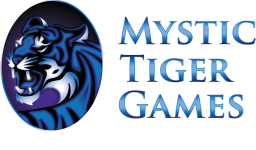Success!
I had my first playtest of Manaforge on Tabletopia last night! It was interesting, to say the least. A few bumps to be sure, but just the fact that I can now host playtests for my game, regardless of where the players are, is awesome.
Stuff that went wrong:
Stuff that went right:
Stuff I can improve:
Overall, I'm very pleased with how this turned out. Only a couple more tweaks to the virtual setup are needed. Hopefully sometime soon I'll also be able to open the room up to 'blind' testing, have me there just as a silent spectator and see what everyone does with the game.
I had my first playtest of Manaforge on Tabletopia last night! It was interesting, to say the least. A few bumps to be sure, but just the fact that I can now host playtests for my game, regardless of where the players are, is awesome.
Stuff that went wrong:
- Even though the playtest had a set start time, it took about a half hour after that before everyone was in the virtual room. I guess punctuality is harder to enforce when you're not physically there.
- One player had a flaky internet connection and dropped out of the game a couple of times. Tabletopia remembered who the player was so they got their seat back when they rejoined, but it still disrupted the game a little.
- All the players had TeamSpeak, but not all of them had microphones. It made back-and-forth communication a little slower.
- Even though the rulebook was readily available, not everyone read it. I still had to explain the rules at the beginning of the game.
- Tabletopia assigns unhelpful player names such as "Player12131" to non-members, so it was a little hard to keep track of who was who. If there is a way to change the default assigned name, I haven't found it yet.
- One player hit the wrong key and rerolled all his dice without meaning to. It would be nice if Tabletopia had an 'undo' function, though I can see how that would be fiendishly difficult to implement.
- Passing the Character cards around for the draft at the beginning is a little awkward. Players had trouble with the way Tabletopia implements each player's hidden 'hand' of cards.
Stuff that went right:
- Setup was a breeze. All the objects were already in the correct locations, and the cards were already shuffled and dealt, thanks to Tabletopia's 'randomize' feature.
- There doesn't appear to be a cap on the number of players in a room. My game only has four 'seats', because it only supports four players, but Tabletopia did not complain at all about there being five people logged in. It doesn't appear that there is a limit on the number of spectators in the room.
- Thanks to TeamSpeak, everyone could hear me talking. It made explaining the game rules a lot faster.
- The turn reference and dice reference sheets were readily available, floating right off to the side of the gameboard. I only got one question about what one of the dice effects was.
- The magnetic effects of the boards worked perfectly. Dealing out item cards from the draw pile went quickly. The cards snapped to the spaces easily and were automatically flipped face up at the same time.
- Even though I couldn't hear most of the players talking, I could still tell what they wanted to do. You can always see where the player's cursors are, so it enabled 'gesturing' as a form of communication. Also the players were moving the dice around to show that they were using them, which was a big help with performing resource math.
- A 6-point spread for four players is very good for my game. (1st place scored 33, 4th place scored 27.) There were no runaway leaders, and nobody was left behind.
- One keypress will let you view a close-up version of a card without having to disturb it. Much better than having to physically pick up the card, which prevents other players from looking at it at the same time.
Stuff I can improve:
- I need to move the unused dice more off to the side. It was sometimes hard to tell what was in play and what wasn't.
- The 'bags' that contain the mana gem tokens are color-coded, but they could probably use some labels too.
- There is only one default camera position, overlooking the entire playfield. It's kind of hard to see details from that high up. Supposedly there is a way to set up more camera presets; having camera positions for each player would probably help.
Overall, I'm very pleased with how this turned out. Only a couple more tweaks to the virtual setup are needed. Hopefully sometime soon I'll also be able to open the room up to 'blind' testing, have me there just as a silent spectator and see what everyone does with the game.

















 RSS Feed
RSS Feed